Ijraset Journal For Research in Applied Science and Engineering Technology
- Home / Ijraset
- On This Page
- Abstract
- Introduction
- Conclusion
- References
- Copyright
Automating Agriculture: The Impact of AI and IoT on Farming
Authors: Atiya Maqbool
DOI Link: https://doi.org/10.22214/ijraset.2025.66183
Certificate: View Certificate
Abstract
The agriculture industry is under tremendous pressure to boost food grain productivity and production due to the effects of climate change and population growth. Agriculture automation is now the only viable choice and a pressing necessity in the majority of nations where agricultural growth is just not feasible. Artificial intelligence and the Internet of Things have already begun to make inroads into every sector, including agriculture. The development of these digital technologies has revolutionized agriculture by enabling intelligent systems that are as intelligent as human experts and are capable of real-time monitoring, control, and visualization of a variety of farm operations. The study discusses the possible uses of AI and IoT in the establishment of smart farm equipment, irrigation systems, greenhouse culture, storage buildings, weed and pest control, manure application, drones for crop monitoring, plant health monitoring, etc. This study\'s main objectives are to give a summary of new studies on agriculture powered by digital technology and to list the most well-known applications of artificial intelligence and the internet of things in agriculture engineering. Scientific databases like Web of Science, PubMed and Scopus have been used to examine research conducted in the fields over the past ten years. It has been found that the utilization of IoT and IoT, from its initial conceptual stage to its implementation stage, the effort to automate agriculture has advanced. The technical features of artificial intelligence and the Internet of Things are also covered, along with the challenges associated with putting these digital technologies into practice. It would aid people in understanding how digitalization may be incorporated into agricultural processes to make it easier for farmers to implement AI and IoT-based solutions.
Introduction
I. INTRODUCTION
The world's population is expected to exceed 10 billion people by 2050 due to its rapid growth. This puts a lot of pressure on the agriculture industry to increase crop production and yield per hectare1. Numerous problems that farmers confront, like shrinking land holdings, scarcity of labor, change in climate, severe weather, dwindling soil fertility, etc., are making agriculture less viable. In recent years, agriculture has been constantly threatened by climate change and other environmental problems, making it very challenging to expand output. The food problem may be solved by expanding land use and farming over a wider area, or by putting best practices and technological assistance into place to increase production. In developing countries with dense populations, when extending geographical space is not possible, the only method to make things smarter is to adopt innovative technology like the internet of things (IoT) and related technologies like artificial intelligence (AI). The "AI" and "IoT" have been identified as crucial techniques for transforming contemporary agricultural operations by recent developments in ICT and related research. Digital technologies such as artificial intelligence and the internet of things can help generate better insights from field data. This allows farming techniques to be methodically planned with less human effort. Value of precision farming has been recognized by the agriculture industry over the years. Precision farming is a sustainable alternative that will boost output by accurately delivering inputs and reducing the misuse of potentially hazardous insecticides and other inputs. Despite the difficulties posed by change in climate and other components, digital technology-driven farming gives variety of methods for automating and increasing agricultural output and production. Real-time analysis in agriculture is made possible by digitization which aids in more efficient water management, land observation, and spraying. In addition to lowering input prices and waste, the agriculture sector will be able to adopt sustainable practices and increase production to satisfy the rising need for food thanks to the application of modern digital technology. Agriculture powered by digital technology is gaining popularity all around the world because of its incredibly easy field administration features as well as reliable real-time monitoring systems. Use of machinery lowered farming practices that previously required draft animal labor and days of human sweat to a few hours of work. This might be seen as the initial degree of automation that revolutionized agricultural work in emerging countries like India.
India is still in the early stages of agricultural mechanization, which is growing at a rate of 7.5% per year. As digital technologies advance, this will become faster and more intelligent. One of the main issues of the modern era is the mass movement of labor.
According to research on the workforce in Indian agriculture, the proportion of workers in this sector fell from 59.1% in 1991 to 54.6% in 2011 and was predicted to reach 40.6% in 20202. These were some of the primary justifications for minimizing the drudgery and advancing toward mechanization. Women workers are able to take the initiative and contribute significantly to agricultural activities when the drudgery associated with agricultural duties is reduced. The degree of mechanization in rice crop cultivation is depicted in Fig. 1. Despite all of these obstacles, agricultural mechanization was essential to boosting economic growth in emerging nations like India3. Because of the increased automation brought about by digital technologies, especially when aided by the IoT and associated techniques, the breadth of agricultural mechanization has expanded in the contemporary digital era.
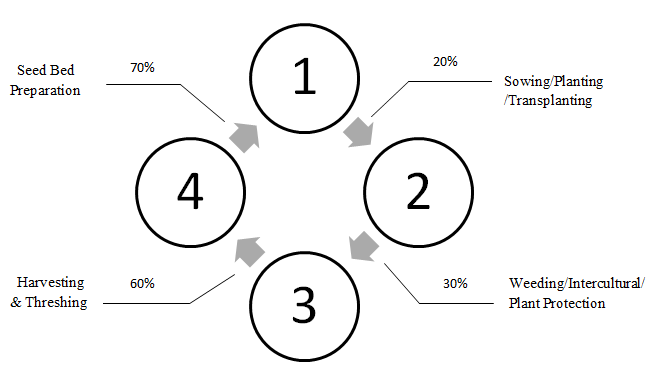
Fig. 1: Mechanization levels for farm operations in rice crop
II. IOT AND AI
Implementation of technology is urgently needed since the demand for food cannot be met by our present traditional farming methods. The automation of agriculture is already benefiting greatly from the IoT, which has capability to revolutionize the industry. It's known as interaction of physical items, or "things," which can interact with their surroundings, gather, share data thanks to network connectivity4. An effective intelligent decision-making system combined with the internet of things can significantly reduce the amount of human intervention required for a variety of agricultural jobs. The system's brain, which makes intelligent decisions, determines whether automated tasks are successful or unsuccessful. When AI and the IoT are combined, strong systems are created which are even more accurate than human judgment. Computer programs that are capable of doing activities like speech recognition, visual perception, decision-making, and language translation that normally need human intellect, are known as AI-enabled systems5. When it comes to automating agricultural chores, AI and the IoT are seen as two sides of the same coin. The primary objective of an IoT device is to produce real-time data, the majority of which is unstructured. Very little data was gathered previously, when gadgets were simpler, and were used to send out simple alert signals that needed less processing. AI algorithms didn't play a part there. Data analysis became more and more necessary as IoT systems became more intricate and advanced. High-quality decision-making can result from AI algorithms' capacity to process data and extract valuable insights. With the advent of new technologies like machine learning, natural language processing, machine vision, artificial neural networks (ANN), etc., problem resolution and automation have become much easier. Among these, ML and artificial neural networks are wide often used techniques in agricultural automation research6.
Both labelled (supervised learning) and unlabelled (unsupervised learning) data can be used by machine learning algorithms. Supervised learning algorithms are used in the majority of data-driven automation and associated processes. The Artificial Neural Network (ANN), which excels at complicated categorization tasks, is a main component of the modern agriculture automation systems. ANN is a layer-based architecture that draws inspiration from biological neurons. They may learn intricate nonlinear correlations because to the architecture. Convolutional Neural Networks are foundation for many deep learning-based computer vision algorithms used in agricultural automation. The scientific community's interest in ANNs has been reignited by CNN's remarkable advancements and outstanding performance in tasks relating to image classification, segmentation, detection, and retrieval7,8.
The numerous feature extraction steps employing a collection of layers and convolution processes are primarily responsible for CNN's potent learning capabilities Fig. 2. A CNN model must pass through a number of layers, including pooling, fully connected, and convolutional (with kernels/filters) layers, in order to categorize the picture. Using kernels, convolution layer is in charge of removing features from the pictures. A 2 dimensional kernel is a weight matrix that moves across the input image data, multiplies the current portion of the input element by element, and then adds up all of the results to a single pixel. An image feature map is produced by this iterative sliding process. For tasks like edge detection, sharpening, blurring, etc., convolutional techniques using various kernels are useful. The activation units, which introduce non-linearity into the model, are given this convolutional kernel output. The most often utilized activation functions are Tanh, Singmoid, and ReLU. CNN's following stage, known as pooling procedure, reduces number of parameters significantly, particularly when images are too big. The key pooling operations used on the feature map are max and min pooling, average and sum pooling. Biggest factor from previous output is found using max pooling. The average of every patch from feature map is determined using average pooling. The values matrix is then sent into a fully connected neural network after being flattened to vector form. Using all of these characteristics, a neural network model is built, and the outputs are categorized into different classes according to the determined probability using activation functions like softmax or sigmoid.
Over time, CNN's structure and functionality underwent changes that enhanced its performance and learning potential. Fig. 3 shows the workflow operations for CNN image classification. NASNet9, EfficientNet10, XceptionNet11, DenseNet12, ResNet5013, AlexNet14, VGGNet15, GoogLeNet16, InceptionNet17, are a few deep learning architectures frequently used for image classification. The main CNN architectures that researchers utilize for image categorization are displayed in Table 1. In a nutshell, AI and the Internet of Things are able to completely change the farming industry so as to fulfil increasing need for food and lessen labor-intensive tasks performed by agricultural workers.
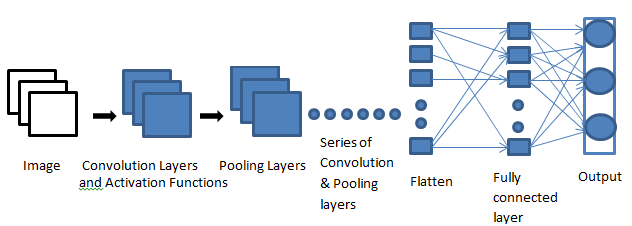
Fig. 2: Architecture of CNN
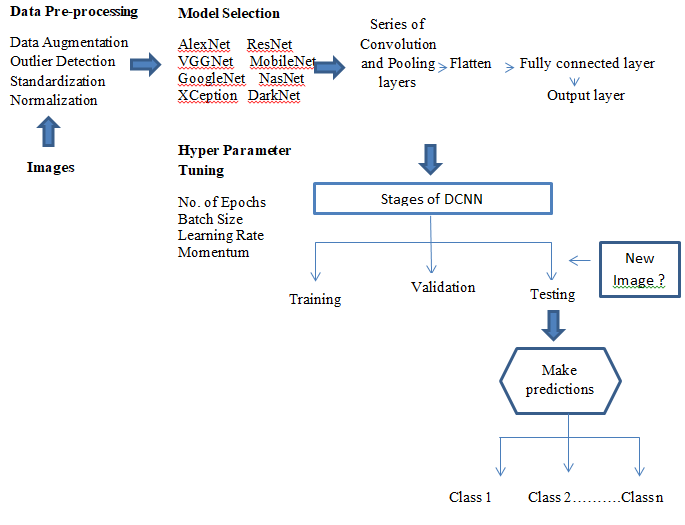
Fig. 3: Pre-trained CNN model
Table 1: Comparison of common CNN based deep learning architectures.
|
Model |
Year |
Image Size |
Depth |
Size in MB |
No. of parameters (million) |
|
AlexNet |
2012 |
227x227 |
8 |
227 |
61 |
|
VGG16 |
2014 |
224x224 |
16 |
515 |
138 |
|
VGG16 |
2014 |
224x224 |
19 |
535 |
144 |
|
GoogleNet |
2014 |
224x224 |
22 |
27 |
7.0 |
|
Inception V3 |
2015 |
299x299 |
48 |
89 |
23.9 |
|
ResNet50 |
2015 |
224x224 |
50 |
96 |
25.6 |
|
ResNet101 |
2015 |
224x224 |
101 |
167 |
44.6 |
|
Xception |
2017 |
299x299 |
71 |
85 |
22.9 |
|
MobileNet |
2017 |
224x224 |
53 |
13 |
3.5 |
|
DarkNet53 |
2018 |
256x256 |
53 |
155 |
41.6 |
III. AN IOT ECOSYSTEM FOR AGRICULTURE DRIVEN BY AI
AI based agricultural smart system combines several techniques to accomplish the desired result. The IoT sensors are placed in intended location at the system's lowest level Fig. 4. These could be sensors placed in a greenhouse, agricultural equipment, ear tags for animals, fields for soil monitoring, and so forth. There are several parts to an Internet of Things device deployed on an agricultural site. Even though the most known gadgets, including the Raspberry Pi, Arduino, and Beagle Bone, frequently has little computational memory, they may nonetheless effectively connect with the outside world by using a communication module. These are able to propagate and receive signals from their surroundings Fig. 5. Real-time environmental changes are recorded by the sensors and transmitted over an IoT gateway to a distant server or cloud. The cloud server or remote server is in charge of data management. Databases are basically used to store data. Conventional relational database is not recommended for holding this type of information because it is large and unstructured. Because they are the most suited for unstructured data and offer faster accessibility, NoSQL databases are widely used on the cloud. Cloud servers are a suitable option for Internet of Things applications because of properties like security, auto-scaling and availability. An AI-enabled data pipeline retrieves information from the database in any format that the analysis tool can handle, such as CSV, Excel, or images. Major role of data pre-processing is data cleaning, which includes things like standardizing and eliminating outliers. Data is breaked into train, validation, and test sets for supervised algorithms.
The data can be processed using a range of techniques. An overview of some AI/ML algorithms frequently employed in agricultural applications is provided in Table 2. The training dataset is used to develop and train a model, while the accuracy and performance of the model are evaluated using test and validation data. K-Fold Cross-validation methods are commonly needed to confirm model stability. Confusion matrices, resulting precision and recall numbers are needed to measure the quality of a classification model. CNN and its variants have demonstrated extremely encouraging outcomes when applied to image data. Convolution operations are used by CNNs, a particular kind of artificial neural network, to extract characteristics from images. Results can be produced using the model for not known information in the cloud after it has been thoroughly evaluated. Now depending on incoming data, Artificial Intelligence model may make predictions as well as conclusions which can be further conveyed to growers and can be used in launching various actions in the field. With a smartphone, growers may quickly obtain recommendations and prediction results in easier-to-understand formats and take the appropriate action. The alerts may come in the form of email and SMS. Grower-friendly online and mobile applications have also been advanced in recent years as a means of informing farmers. Mobile applications also give the farmer management over farm operations. The actuators can take the required actions in response to the control signals they can give.
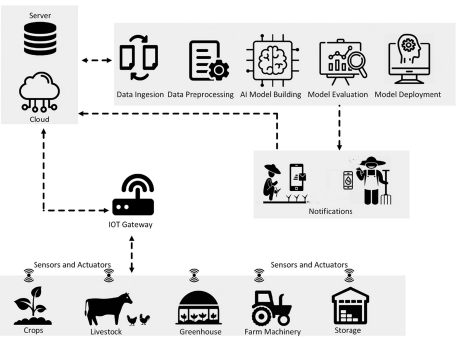
Fig. 4: Generalized IoT-artificial intelligence workflow for agriculture solutions
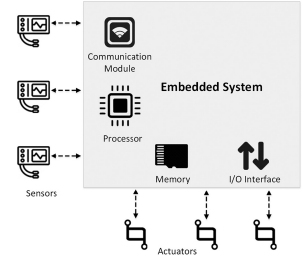
Fig. 5: Architecture of IoT device
Table 2: AI/ML algorithms and applications in agriculture
|
AI/ML Algorithm |
Type |
Description |
|
Recurrent Neural Networks and LSTM |
Time Series Analysis and Classification |
Text classification, Summarization, Time series analysis, Forecasting. |
|
K-NN Model |
Classification |
Classification using non-parametric instance based model |
|
Naïve Bayes |
Classification |
Classification using probabilistic model |
|
Tree Based Models |
Classification and Regression |
Tree based classification and Regression. |
|
Convolutional Neural Network |
Classification |
Models used are: AlexNet, VGG16, VGG19, InceptionV3, DenseNet201, MobileNet, EfficientNet, Xception, InceptionResNetV2 and NASNetMobile SqueezeNet and Data consist of Images and Videos |
|
Support Vector Machines |
Classification and Regression |
Classification of linear and non-linear data, Image classification |
IV. APPLICATIONS OF ARTIFICIAL INTELLIGENCE AND INTERNET OF THINGS IN AGRICULTURE AUTOMATION
Through the introduction of increasingly intelligent apps, the precision and control of farming techniques could be greatly enhanced by the AI-powered IoT environment. Because modern technology can automate complicated operations with little operator interaction, their applications in agriculture are virtually limitless. The following provides a basic overview of how AI and IoT are being used in agricultural engineering Fig. 6.
A. Automated Mechanization
1) Tractor Performance Tracking and Navigation
Modern growers carry out a variety of agricultural duties using a various kinds of farm machinery and equipment. Among them, tractors are thought to be the most significant and essential piece of farm power equipment. Without a doubt, tractors are an essential part of farm mechanization and are constantly adding to the daily rise in agricultural productivity. As important component of agricultural mechanization system, the tractor-implement system's performance monitoring is crucial. The entire process is measured, recorded, and remotely visualized with the use of tractor performance monitors. Wheel slip, draught, power, and fuel consumption are the elements that are typically taken into account. Tractor performance can be significantly increased by optimizing these factors. The draft was measured using a strain gauge mounted on a ring transducer at the front end of the drawbar. Wheel speed is detected using toothed gears and magnetic pick-ups, while fuel consumption is measured using a positive displacement flow meter. 18A data collection system can also be used to monitor the working, when the transducers are installed to measure different functional parameters. The tractor-implement performance can be spatially mapped using the Differential Global Position System (DGPS).
The Global Positioning System (GPS) is crucial part of this system which gives spatial values. It enables tractor-implement system's performance to be tracked, measured, and recorded in respect to the position.
This mapping approach is very helpful for calculating crop production costs inside field border, taking into account elements like soil condition and land slope19, 20. Tractors with sensors and an integrated navigation system are now common on farms in industrialized nations, keeping an eye on all macro- and micro-scopical aspects of the land. These days, with farms becoming increasingly internet-enabled and linked, the full potential of IoT and similar techniques may be used to record tractor performance. Both hardware and software components make up a general system that focuses on tractor's performance or navigation. Hardware component includes the sensors required to measure fuel flow, power usage, and geo-location. After that, a PCB or processing unit receives these data. Well suited communication method, like Low Powered Wide Area Network, is used to transfer data to the network. Web applications created by connecting to a scalable and real-time database are used for the software side21.
2) Autonomous tractors and farm machinery
Low productivity and a lack of competent workers are ongoing problems in the agriculture business. Cultivators, tractors and plows which need little human intervention have been made possible by technological advancements22. Autonomous vehicles typically employ radars and lasers to identify impediments and respond to them intelligently. Tractors are unable to discriminate between barriers and grass, the same cannot be said for them. Therefore, it cannot be driven in the same way as other autonomous cars. One popular technique that enables the machine to find itself and move to a site on its own is the Global Navigation and Satellite System (GNSS). However, model wouldn't be aware of its environment which may tend to collision. Moreover, autonomous driving will not be feasible in an area resembling an orchard. Therefore, sensors, stereocameras, and deep learning algorithms are essential parts of contemporary autonomous agricultural systems. An RGB camera with various infrared sensors can be utilised for stereo matching for creating the deep pictures.
The popular CNN-based YOLO technique is used for object detection23. This finds items within the pixel bounding boxes24. Manufacturers of Tractor such as John Deere and Case IH had already started providing farmers in other countries with autonomous tractors. LiDAR (Light Imaging, Detection, and Ranging) and cameras were added to Case IH's concept tractor so that it could precisely detect impediments. A few alternative object identification systems are used for object recognition in agricultural applications are SSDs25 and faster RCNN26. Adopting deep learning-based computer vision techniques, researchers have created autonomous tractors, rice transplanters, and harvesters with almost the same human efficiency. An image capture module and an image manipulation module installed on a self-propelled carrier made up the majority of the autonomous fruit harvester prototype27. To determine which horticultural crops are needed to be harvested, the data was incorporated into an object detection algorithm based on computer vision.
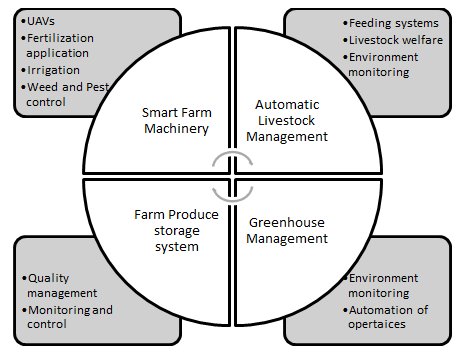
Fig. 6: Agriculture automation applications using AI-IoT
3) UAV or drones
Drones were first used for military purposes, but they have gradually begun to be used for agricultural purposes. Another innovation in agriculture is the use of drones to automate many activities, including monitoring the field and spraying pesticides. Unmanned aerial vehicles (UAVs) that do not have a human pilot on board are known as agricultural drones. Fig. 7 depicts a generic drone setup. Using protocols like Mavelink, the base station is head of communicating with the drone. The majority of ground control stations have a user interface for drone monitoring. In order to regulate the UAVs' pitch, row and yaw, the hardware is crucial. The drone device is composed of a central processing unit, a number of sensors, such as a laser, radar, camera, gyroscope, accelerometer, compass, GPS receiver for reading environmental data, and actuators and motors for performing necessary duties. The remote control is utilized to communicate with this, and radio frequency communication is used. Because UAVs are fitted with temperature and multispectral sensors, they monitor acres of land in one flight28,29. Bands with varying wavelengths can be captured by the cameras, and indices like the NDVI could be computed using the formula based on the reflectance readings. The formula is NDVI ¼ ð Þ RINR–RRED = ð Þ RINR þ. where RRED stands for Reflectance in the Red range of the red band and RINR for Reflectance in the Near Infra-red band. NDVI values vary from -1 to 1, here, 0 denotes no plantation and 1 represents the dense crop density30,31. These kind of analyses aid in determining the insect attacks and crop health. Another important feature of drone application is use of insecticides. Controller and spraying system are 2 main components of the system. Spraying systems are often connected to pesticide tank and mounted on the lower portion of the UAV. Controller is used to activate the sprayer's nozzle. In order to revolutionize contemporary precision farming, the agriculture industry has currently embraced drone technology wholeheartedly32. Startups and research groups in India are taking advantage of the potential of drones in agriculture to monitor crop health and make data-driven decisions on the land. India offers countless prospects for drone-based solutions because of the country's terrain, which makes ground-based assessments expensive and time-consuming. Establishing precise rules for drone use is the main obstacle33.
V. SYSTEMS OF IRRIGATION
Efficient use of water is crucial for meeting our future food needs, and the "per drop more crop" approach has been found to be the most effective way to use the limited water supplies. The development of the IoT has advanced technical assistance for effective management of water, which had been underway for years. Cloud computing and artificial intelligence-enabled decision support systems and the Internet of Things can be used to intelligently automate the entire irrigation system workflow Fig. 8. The sensors for temperature, humidity, and soil moisture serve as the primary source of information entered into the system.
The data are kept in a database so that the model can be trained using historical data for a more thorough analysis. The good-to-go classification method is an artificial neural network that can be trained using database data to create the model. The model can be used to categorize unknown data after it has been trained. Data from sensors is transferred via protocols like MQTT, enabling real-time monitoring. Only individuals who have subscribed to subjects can read information in MQTT, where it is released to the subjects. MQTT has the advantage of being lightweight and easily manageable by the network. Module has a relay and motor attached to it, and processing unit will be prepared to receive external demands. An MQTT dashboard can be used to visualize the data34. Irrigation relies significantly on subsurface water in isolated areas with severe water constraint. The pumps should be turned on and off based on the well's water level. Since diesel engine-powered pumps are often water-cooled, low water levels can also harm the pump. Therefore, in addition to the irrigation design, appropriate well water level monitoring may be taken into consideration.
An Internet of Things (IoT)-based solar energy system for intelligent irrigation can be created in areas with limited electricity and water resources. In those systems, solar energy can be used to charge the battery during sunny days. These systems have sensors to measure temperature, humidity, and soil moisture, just as traditional irrigation systems. In addition, a flow rate sensor can be used to regulate the flow rate. The energy-saving requirements are the main emphasis of these systems' design. The current irrigation technique is enhanced by a control algorithm that makes use of fuzzy logic. It is possible to create conditions that will cause the water pump to run at the right times by varying the input values. These solutions are accessible from any location through remote monitoring via web or mobile applications35.
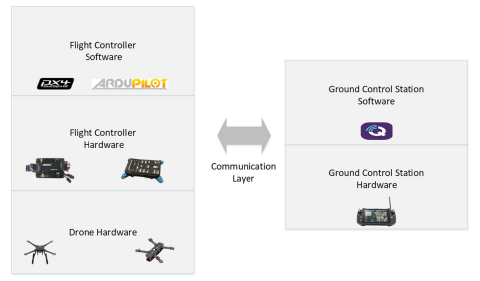
Fig. 7: Architecture of Drones
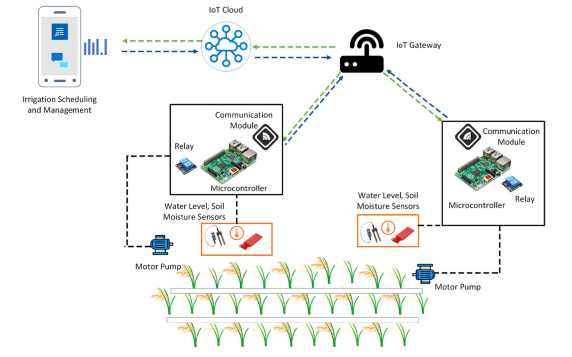
Fig. 8: Automated Irrigation system using IoT
VI. MANURE APPLICATION
In addition to weeds, one of the main causes of the agricultural land's poor output is the use of either too little or too much fertilizer. Before applying fertilizers, soil testing is unavoidable and indicates the crop's nutrient needs. Farmers frequently omit this step due to the intricate laboratory procedures. Organizations are encouraging farmers to use technology-enabled farming methods and go digital these days. IoT technology can aid in more intelligent fertilizer application. An Nitrogen, Phosphorous, Potassium sensor, could be made with light-emitting diodes (LED), light-dependent resistors, and resistors, can be used to measure the amounts of N, P and K. Colorimetric and photoconductivity concepts underpin the sensor's operation. The NPK sensor directly sends the values to a processing unit or system-on-a-chip. For investigation, either fog computing or edge computing are employed. The CPU in direct contact with the sensors does fog computing, whereas an edge server connected to the internet performs edge computing. Fuzzy logic can be used in assessing and calculating the requirement of manure which is required to be applied. Because cloud services like Google Cloud Platforms provide scalable, timely, and uninterrupted service, this method can be applied to SMS service. The recommended fertilizer dosages are typically sent to farmers' phones via text message36.
VII. WEED AND PEST CONTROL
Herbicide use for weed control is still difficult since it might have negative consequences for the environment and human health. Furthermore, typical weeding techniques result in higher pesticide costs and more greenhouse gas emissions since they administer herbicides consistently throughout the field, regardless of the presence of weeds. One practical way to get around all of these issues is by creating a location-specific model that combines robotics, IoT, and sophisticated picture analysis methods. Both RGB and infrared (IR) imaging sensors must be employed to detect weeds in a field. A pre-processing component receives these field-captured photos. The pre-processing part is in charge of normalization, color space modification, scaling, and transformation. The pre-processed output undergoes segmentation, which groups related pixels to create a connected object with uniform characteristics. This entails gathering only the vegetation portion and removing the plants from the soil and other backdrops. The following step, known as feature extraction, removes the segments' key characteristics. These consist of spatial settings, visual textures, spectral characteristics, and biological morphology.
An increase in dimensionality is the outcome of extracting and combining different features. Only the most important feature combinations are chosen for efficacy utilizing a variety of methods, including Principal Component Analysis (PCA), Linear Discriminant Analysis (LDA), Stepwise Linear Discriminant Analysis (SWLDA), and others. Either traditional ML or DL based algorithms could be used for final classification of crops and unwanted plants. ANN and SVM are 2 important classifiers which are frequently used in weed recognition. SVMs have shown effective in the field for weed identification in maize fields37. Recent research indicates that Convolutional Neural Networks (CNNs) perform better than other classifiers when assessing images. CNN's only drawback is that it requires learning a lot of parameters when features are huge. It requires more expensive hardware and adds a significant computational effort. Pre-trained models can be used to get around this and provide state-of-the-art performance38. Processing components or system-on-a-chip, like Raspberry Pi, sensors, cameras, and a sprayer, enabling Internet of Things-based weed control systems. The essential component of the Because it can significantly reduce the use of pesticides and, consequently, health-related issues, the Internet of Things-based weed management system is a very promising automation39. Conventional pest management techniques rely significantly on chemicals, and people are growing more worried about how they affect soil quality and human health. The internet of things can be used to plan different ways to protect crops from pests. IoT devices can be used to remotely monitor insect activity, such as woolly apple aphid in apple orchards. Preparing for the countermeasures is facilitated by this. The weather has a significant impact on the growth of pest populations. IoT can support extremely accurate and timely remote weather monitoring.
AI-enabled devices and image processing can automatically evaluate crop development and warn of the likelihood of insect assaults. One of the most recent advancements in insect management is formation of early warning models. Initially, these data-driven algorithms collect a lot of information which tend to spread of pests. A neural network is trained utilizing real-time data collection from the farms regarding climate, weather, soil and other environmental elements so as to predict degree of insect abundance in the field40. It has also been shown that faster R-CNN (faster region-based convolutional neural network) object identification is very successful in detecting pests in big farms and greenhouses41.Modern spraying equipment, such as air-assisted sprayers, ULV sprayers, ultrasonic sensor-based sprayers, canopy sprayers, and electrostatic sprayers, can boost spraying efficiency. This will reduce the need for pesticides, the dangers of over-dosage, contamination of soil and water by reducing the rate of application and the number of sprays in horticultural crops and the field.
VIII. AUTOMATED LIVESTOCK MANAGEMENT
Crucial part of rural development and subsistence is livestock. As per previous experiments, there is a significant yield gap as a result of farmers using antiquated methods. Main problem is how to plan, coordinate the expansion of this cattle industry to reduce the production gap. As a result, a research opportunity exists that can offer a sustainable solution with the aid of cutting-edge technologies. The health and welfare of the cattle is ensured by Precision cattle Farming (PLF) system, by automating the entire analysis, monitoring and decision-making process. Majority of rural areas still practice backyard poultry, which is quite beneficial to women's organizations. For management of poultry, precision feeding system, environment and chicken welfare are the three primary facets of precision poultry farming. Multiple sensors are used to measure humidity, temperature and chemicals like ammonia and CO2 that affect the health of bird are part of environment monitoring systems. Furthermore, broiler weight can be predicted up to 72 hours ahead of time using deep learning-based prediction algorithms. Additionally, robotics is a crucial technology for managing poultry operations42. The health of birds can improve by autonomous robot while as sophisticated robots can be used for aeration of poultry floor's litter. By doing this, the chances of diseases and illnesses like Salmonella will be reduced. Precision feeding systems can be used for careful feed intake. According to recent studies, more viable eggs are produced by Precision-fed broiler breeders43. Welfare monitoring systems, on the other hand, are supported by sophisticated big data analytics and use non-invasive technology like digital imaging and vocalization analysis. Better knowledge of cattle's health, early disease detection, feed intake, heat, and estrus episodes can be gained through behavior analysis. Keeping an eye on every cow on the farm is frequently a laborious task that necessitates careful monitoring. Some automated monitoring solutions that can be used in both small and large-scale cattle ranches are animal-attached sensors44. Sensors that are affixed to an animal's leg, neck, or ear, sensor nodes that analyze and communicate the observations, and an AI-enabled model that updates the animal's status are all common components of the current behavior monitoring and analysis automation system Fig. 9. The time-series data produced by the sensors is incorporated into the machine learning models that have been constructed. Selecting only pertinent properties are needed for constructing the IoT system which is frequently a good idea. Techniques are used for this feature selection in order to determine the optimal feature combination that can be useful in Two methods—Stratified Cross-Validation (SCV) and Leave Out One Animal (LOOA)—are used to assess the algorithm's performance. The information from the surviving animals serves as the test set in LOOA, while information from other animals serves as training set. All of the animals' data are merged and assessed using the SCV method, which is comparable to K fold cross-validation45. The timely and effective reproduction of cattle is a major factor in dairy farm productivity. The lack of methods for promptly identifying the calving and estrous episodes makes the conventional artificial insemination system inaccurate. Information regarding the cattle's current condition can be collected by smart models which contain sensors such as pedometer, temperature and accelerometer. Patterns as well as duration of activity differ from usual during calving and estrus events. An AI algorithm may examine this pattern from the gathered data to find activity irregularities. Feeding time, hourly rumination time and resting time are the 3 crucial factors which impact the cattle's condition. The accelerometer data makes it simple to collect these. The accelerometer on the cattle's neck is used to measure their rumination and feeding times, while the accelerometer on their leg is used to measure their standing time. Any binary classification model, including logistic regression, can be used to determine whether the cattle are in estrus46. Complex decision-making is necessary for an AI-based system for cattle management and data analysis is regularly carried out in distant servers or the cloud. It is because of the micro-controller in the ear or collar, which uses a lot of electricity for complicated calculations and has relatively little processing power. Systems for automating livestock are likewise data-driven, with the majority of cattle data being unstructured. This may belong to the following categories: text, image, audio, etc. In general, statistical techniques don't work well with noisy and unstructured data. Multi-layer perceptron feed forward neural networks work well in pattern recognition or simple categorization applications47. CNN and their variations, however, have been depicted to be significantly more accurate for image processing.
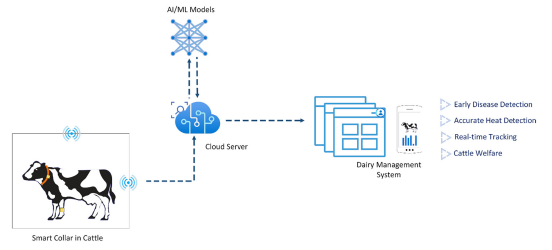
Fig.9: Smart Collar system for Smart Diary Management
IX. GREENHOUSE MANAGEMENT
Because so many factors are involved, maintaining the greenhouse's environmental variables is a laborious task. Climate change is one of the factors where technology can make farming easier than ever before because it could damage plants. Sensors could be utilized in quantifying local climatic as well as environmental factors of contemporary greenhouses. Wireless sensor networks with many nodes can distribute information to stakeholders due to sensors and actuators. A base station that oversees wireless sensor network data handling sub-systems48 is usually included in the architecture. The best option for data storage is remote server or cloud server48. The architecture is somewhat comparable to that of other monitoring systems based on the IoT. With the aid of these systems, a considerable degree of actuation can be carried out in addition to monitoring. Any connection technology, such as Bluetooth or Zigbee, can be used to connect the equipment, which gathers soil moisture data. The associated micro-irrigation system may be triggered when the moisture content drops below the threshold. The same workout could be carried out for temperature and humidity. A public dashboard that is accessible from anywhere can be created using the data. Due to favourable environment within greenhouse, pest assaults are another serious problem that greenhouses are currently facing. Therefore, one of the most important components of an effective greenhouse deployment is Integrated Pest Management (IPM). Using sticky paper traps, which can draw pests, is the simplest technique that is frequently used. The pest's approximate population density can be found on this sticky paper. This aids in the development of accurate pest management and control plans. This issue can be partially resolved by employing image processing methods to further automate this manual inspection. The use of micro-controller-enabled monitoring can result in a completely automated system. This technique uses RGB cameras positioned throughout the greenhouse to gather images of sticky paper. RGB camera is connected with Raspberry Pi or Arduino, which serves as the system's central processing component. The nodes of sensor are often constructed with a waterproof design, and they are joined in a star shaped topology to transmit information to the world via Gateway. Using the HTTP POST protocol, images can be sent to the distant server. At the server, more image analysis might be carried out. The results of the data are presented on server-maintained dashboard. For analysis purposes, standard ML technologies like SVM with an appropriate kernel (radial basis kernel) could be employed. For successful modelling and training of data for the recognition of unknown pests, entomologists label the insects49. It has also been observed that detection models perform well for detecting minute pests in polyhouses50. It is advisable to conduct an assessment of the environmental conditions within the polyhouses before they are used for crop production. The greatest feasible design of energy-efficient greenhouses is aided by adaptive climate control techniques. Data gathering as well as analysis aids in monitoring and planning cost-cutting strategies for cooling systems, which are often affordable for farms. A relationship between crop growth and microclimate variation can also be created with the use of the decision support systems and Internet of Things, giving growers a better understanding of crop growth rate prior to planting. Temperature, humidity, vapour pressure, sun radiation, and other field variables are analyzed using a model that simulates the comfort ratio for different crop growth phases. This might be utilized to develop more effective control suggestions for greenhouse management51.
X. STORAGE SYSTEMS FOR FARM PRODUCE
Even with the advancements in technologies which have been incorporated into everyday agricultural operations, some jobs, like keeping an eye on the farm produce storage systems, were still completed by hand. An very minor human error in this task could result in a persistent and significant problem for farm and supply chain as a whole. The internet of things can also be a suitable option in this situation because people often turn to technology for help. The food quality of the farm kept in storage containers may be efficiently monitored with wireless sensor nodes. Humidity and temperature sensors could be used to make sure the storage is at the ideal temperature and humidity. Sensor nodes are connected to the internet via a gateway and the distant database server handles data aggregation. The farmers can keep an eye on the storage conditions locally by connecting the data insights to the interface for graphical users. In affluent nations, growers use this procedure extensively in systems for storing seed potatoes52. To guarantee food security during storage, it's also critical to find and eliminate residues of pesticides. Convolvulus neural network algorithms may use hyperspectral pictures of horticultural crops to detect pesticide residues effectively53. A technique for managing cold storage is usually created to work in a controlled environment. Long-term storage of agri-horticultural products is one more benefit from automated cold storage systems54. In addition to the container's temperature and humidity, MQ sensors are frequently used to monitor the carbon monoxide levels for improved management. Certain storage systems employ smoke sensors to identify any type of fire and LDR sensors to provide adequate lighting. Data is managed locally rather than on cloud platforms if the system doesn't need sophisticated analytics.
XI. POSSIBILITIES AND CHALLENGES
Farmers' lack of technical proficiency in using technology-driven equipment is one of the largest issues facing the ecosystem, despite the fact that technology has the ability to totally alter the agricultural sector. The easiest way to deal with this is to design the systems with farmers in mind. Designers of digital products need to focus on the user interface, and providing solutions in local languages is one possible approach. Small-scale farmers are mostly worried about the price and caliber of the tools and sensors when it comes to using new technologies. In Internet of Things solutions, system dependability is extremely crucial. Dangers to the operation or breakdown of any part will tend to reliability problems because agricultural activities are directly impacted by judgments made with the use of decision support systems. As a network of widely dispersed small objects, IoT systems have very limited processing and storage capacity, which poses a challenge to the data security and management of ordinary AI applications. Making the most of these networks with limited resources requires the use of appropriate data management techniques. Interoperability is essential because IoT devices are heterogeneous, and appropriate synchronization across devices is necessary for optimal execution. This is a hard task because there are various vendors and a lot of devices. Another significant issue that academics have tackled is the variety of the information from the gadgets, which may be unstructured, structured, or even semi-structured. All types of data should be managed and handled by the system. This difficulty could be addressed by designing cloud-based applications for IoT, because these services are highly scalable and offer enormous computational power and storage capacity. The quality of decision-making in AI algorithms can be determined by quantity and quality of data. Obtaining a substantial quantity of quality data is crucial in developing AI-based models. It is clear that security is a main worry among five primary obstacles to the implementation of analytics and IoT solutions as depicted in Fig. 1055. Compared to other applications, agriculture solutions handle a lot less personal data. Nevertheless, a channel is used to transmit the farm and crop data, there are likely to have a security breach. Another important issue that requires attention is the delay in communication. AI solutions are designed to function in real-time, the messages and data supplied to the end user should arrive on schedule. The user must act on the information immediately, any information that is delayed will be useless. AI based technologies are extending as well as increasing the potential for greater value capture and development. They are expected to make agriculture smarter as well as more automated in the future, despite all the obstacles. Agricultural methods could be revolutionized by utilizing these technologies. The advancement of 5G technology will be crucial to maximizing the IoT promise in the years to come. 5G networks have 100 times the capacity of 4G networks, which can greatly increase internet speed. Communication latency will be addressed via 5G development, which is a limitation in existing systems, allowing for faster reaction times than the speed of light. In the coming years, embedded technologies and sensors will remain broadly accessible and less expensive, which will make IoT extremely promising. The formation of complex algorithms and AI supports decision-making of increasingly intelligent apps.
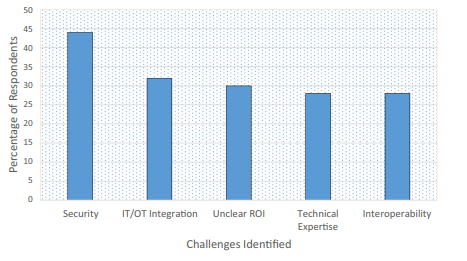
Fig.10: Main Barriers in the adoption of IoT solution
Conclusion
A thorough analysis of Internet of things and Artificial Intelligence based automation of agricultural and digitalization has been provided in this paper. IoT and AI are necessary for all the events of farming practices, both before and after harvesting. The technologies, including crop monitoring to autonomous harvesting robots, are progressively changing as well as enhancing speed and ease of grower’s lives. This study leads to the following conclusions. AI and the IoT are advancing modern farming by digitalizing and automating agricultural processes. Multiple sensor data must be handled and evaluated using ML and DL-based methods in order to forecast future problems in agricultural activities. The creation of intelligent farm equipment, intelligent irrigation systems, weed and insect management, fertilizer application, greenhouse management, storage systems, etc. are some possible uses of automation and digitalization in agriculture. Through object recognition and classification, CNN and their variants have significantly improved agricultural automation and image identification. The security aspect of digitization adoption is a hurdle. Since the method is entirely data-driven, the local networks must be protected from network disturbance. As IoT and AI-enabled goods become more reliable and affordable, it is inevitable that the agriculture industry will use them widely. Researchers, agricultural entrepreneurs, and other stakeholders can choose the best models and methods for accomplishing a goal by using the most recent data and analysis of deep learning models described in the paper.
References
[1] FAO, 2017. The Future of Food and Agriculture: Trends and Challenges. FAO [2] Mehta, C.R., Chandel, N.S., Senthilkumar, T., 2014. Status, challenges and strategies for farm mechanization in India. Agric. Mech. Asia Afr. Lat. Am. 45, 43–50. [3] Mehta, C.R., Chandel, N.S., Jena, P.C., Jha, A., 2019. Indian agriculture counting on farm mechanization. Agric. Mech. Asia Afr. Lat. Am. 50, 84–89. [4] Matta, P., Pant, B., 2019. Internet-of-things: genesis, challenges and applications. J. Eng. Sci. Technol. 14, 1717–1750. [5] Yang, L.B., 2020. Application of artificial intelligence in electrical automation control. Procedia Comput. Sci., Proceedings of the 3rd International Conference on Mechatronics and Intelligent Robotics (ICMIR-2019). 166, pp. 292–295. https://doi. org/10.1016/j.procs.2020.02.097. [6] Jha, K., Doshi, A., Patel, P., Shah, M., 2019. A comprehensive review on automation in agriculture using artificial intelligence. Artif. Intell. Agric. 2, 1–12. https://doi.org/10. 1016/j.aiia.2019.05.004. [7] Cire?an, D., Meier, U., Masci, J., Schmidhuber, J., 2012. Multi-column deep neural network for traffic sign classification. Neural Netw. 32, 333–338. https://doi.org/10.1016/j. neunet.2012.02.023. [8] Indolia, S., Goswami, A.K., Mishra, S., Asopa, P., 2018. Conceptual understanding of convolutional neural network- a deep learning approach. Procedia Comput. Sci. 132, 679–688. https://doi.org/10.1016/j.procs.2018.05.069. [9] Krizhevsky, A., Sutskever, I., Hinton, G.E., 2012. ImageNet classification with deep convolutional neural networks. In: Pereira, F., Burges, C.J.C., Bottou, L., Weinberger, K.Q. (Eds.), Advances in Neural Information Processing Systems. 25. Curran Associates, Inc, pp. 1097–1105. [10] Simonyan, K., Zisserman, A., 2015. Very Deep Convolutional Networks for Large-Scale Image Recognition. ArXiv14091556 Cs. [11] Szegedy, C., Liu, W., Jia, Y., Sermanet, P., Reed, S., Anguelov, D., Erhan, D., Vanhoucke, V., Rabinovich, A., 2014. Going Deeper with Convolutions. ArXiv14094842 Cs. [12] Szegedy, C., Ioffe, S., Vanhoucke, V., Alemi, A., 2016. Inception-v4, Inception-ResNet and the Impact of Residual Connections on Learning. ArXiv160207261 Cs. [13] He, K., Zhang, X., Ren, S., Sun, J., 2015. Deep Residual Learning for Image Recognition. ArXiv151203385 Cs. [14] Huang, G., Liu, Z., van der Maaten, L., Weinberger, K.Q., 2018. Densely Connected Convolutional Networks. ArXiv160806993 Cs. [15] Chollet, F., 2017. Xception: Deep Learning with Depthwise Separable Convolutions. ArXiv161002357 Cs. [16] Tan, M., Le, Q.V., 2020. EfficientNet: Rethinking Model Scaling for Convolutional Neural Networks. ArXiv190511946 Cs Stat. [17] Adam, G., Lorraine, J., 2019. Understanding Neural Architecture Search Techniques. ArXiv190400438 Cs Stat. [18] Grogan, J., Morris, D.A., Searcy, S.W., Stout, B.A., 1987. Microcomputer-based tractor performance monitoring and optimization system. J. Agric. Eng. Res. 38, 227–243. https://doi.org/10.1016/0021-8634(87)90091-6. [19] Yahya, A., Zohadie, M., Kheiralla, A.F., Giew, S.K., Boon, N.E., 2009. Mapping system for tractor-implement performance. Comput. Electron. Agric. 69, 2–11. https://doi.org/ 10.1016/j.compag.2009.06.010. [20] Yule, I.J., Kohnen, G., Nowak, M., 1999. A tractor performance monitor with DGPS capability. Comput. Electron. Agric. 23, 155–174. https://doi.org/10.1016/S0168-1699(99) 00029-0. [21] Civele, Ç., 2019. Development of an Iot based tractor tracking device to be used as a precision agriculture tool for Turkey’s agricultural tractors. Sch. J. Agric. Vet. Sci. 6, 199–203. https://doi.org/10.36347/SJAVS.2019.v06i09.001. [22] Mehta, C.R., Chandel, N.S., Rajwade, Yogesh, 2021. Smart farm mechanization for sustainable Indian agriculture. Agric. Mech. Asia Afr. Lat. Am. 50, 99–105. [23] Redmon, J., Divvala, S., Girshick, R., Farhadi, A., 2016. You only look once: unified, realtime object detection. 2016 IEEE Conference on Computer Vision and Pattern Recognition (CVPR). Presented at the 2016 IEEE Conference on Computer Vision and Pattern Recognition (CVPR), pp. 779–788 https://doi.org/10.1109/CVPR.2016.91. [24] Inoue, K., Kaizu, Y., Igarashi, S., Imou, K., 2019. The development of autonomous navigation and obstacle avoidance for a robotic mower using machine vision technique. IFAC-Pap., 6th IFAC Conference on Sensing, Control and Automation Technologies for Agriculture AGRICONTROL 2019. 52, pp. 173–177. https://doi.org/10.1016/j. ifacol.2019.12.517. [25] Liu, W., Anguelov, D., Erhan, D., Szegedy, C., Reed, S., Fu, C.-Y., Berg, A.C., 2016a. SSD: Single shot multibox detector. In: Leibe, B., Matas, J., Sebe, N., Welling, M. (Eds.), Computer Vision – ECCV 2016, Lecture Notes in Computer Science. Springer International Publishing, Cham, pp. 21–37 https://doi.org/10.1007/978-3-319- 46448-0_2. [26] Ren, S., He, K., Girshick, R., Sun, J., 2016. Faster R-CNN: Towards Real-Time Object Detection with Region Proposal Networks. ArXiv150601497 Cs. [27] Blok, M.P., Barth, R., den van Berg, W., 2016. Machine vision for a selective broccoli harvesting robot. IFAC-Pap. 66–71. [28] El Hoummaidi, L., Larabi, A., Alam, K., 2021. Using unmanned aerial systems and deep learning for agriculture mapping in Dubai. Heliyon 7, e08154. https://doi.org/10. 1016/j.heliyon.2021.e08154. [29] Mogili, U.R., Deepak, B.B.V.L., 2018. Review on application of drone systems in precision agriculture. Procedia Comput. Sci., International Conference on Robotics and Smart Manufacturing (RoSMa2018). 133, pp. 502–509. https://doi.org/10.1016/j.procs. 2018.07.063. [30] Bhandari, A.K, Kumar, A., Singh, G.K., 2012. Feature Extraction using Normalized Difference Vegetation Index (NDVI): A Case Study of Jabalpur City. Procedia Technology 6, 612–621. https://doi.org/10.1016/j.protcy.2012.10.074. [31] Reinecke, Marthinus, Prinsloo, Tania, 2017. The influence of drone monitoring on crop health and harvest size. 1st International Conference on Next Generation Computing Applications (NextComp), 5–10 https://doi.org/10.1109/NEXTCOMP.2017.8016168. [32] van der Merwe, D., Burchfield, D.R., Witt, T.D., Price, K.P., Sharda, A., 2020. Chapter one - drones in agriculture. In: Sparks, D.L. (Ed.), Advances in Agronomy. Academic Press, pp. 1–30 https://doi.org/10.1016/bs.agron.2020.03.001. [33] Sylvester, G., 2018. E-Agriculture in Action: Drones for Agriculture. FAO, Bangkok, Thailand [34] Nawandar, N.K., Satpute, V.R., 2019. IoT based low cost and intelligent module for smart irrigation system. Comput. Electron. Agric. 162, 979–990. https://doi.org/10.1016/j. compag.2019.05.027. [35] Al-Ali, A.R., Al Nabulsi, A., Mukhopadhyay, S., Awal, M.S., Fernandes, S., Ailabouni, K., 2019. IoT-solar energy powered smart farm irrigation system. J. Electron. Sci. Technol. 17, 100017. https://doi.org/10.1016/j.jnlest.2020.100017. [36] Lavanya, G., Rani, C., Ganeshkumar, P., 2019. An automated low cost IoT based Fertilizer Intimation System for smart agriculture. Sustain. Comput. Inform. Syst. https://doi. org/10.1016/j.suscom.2019.01.002. [37] Akbarzadeh, S., Paap, A., Ahderom, S., Apopei, B., Alameh, K., 2018. Plant discrimination by support vector machine classifier based on spectral reflectance. Comput. Electron. Agric. 148, 250–258. https://doi.org/10.1016/j.compag.2018.03.026. [38] Wang, A., Zhang, W., Wei, X., 2019. A review on weed detection using ground-based machine vision and image processing techniques. Comput. Electron. Agric. 158, 226–240. https://doi.org/10.1016/j.compag.2019.02.005 [39] Dankhara, F., Patel, K., Doshi, N., 2019. Analysis of robust weed detection techniques based on the internet of things (IoT). Procedia Comput. Sci., The 10th International Conference on Emerging Ubiquitous Systems and Pervasive Networks (EUSPN2019) / The 9th International Conference on Current and Future Trends of Information and Communication Technologies in Healthcare (ICTH-2019) / Affiliated Workshops. 160, pp. 696–701. https://doi.org/10.1016/j.procs.2019.11.025. [40] Cai, J., Xiao, D., Lv, L., Ye, Y., 2019. An early warning model for vegetable pests based on multidimensional data. Comput. Electron. Agric. 156, 217–226. https://doi.org/10. 1016/j.compag.2018.11.019 [41] Karar, M.E., Alsunaydi, F., Albusaymi, S., Alotaibi, S., 2021. A new mobile application of agricultural pests recognition using deep learning in cloud computing system. Alex. Eng. J. 60, 4423–4432. https://doi.org/10.1016/j.aej.2021.03.009. [42] Astill, J., Dara, R.A., Fraser, E.D.G., Roberts, B., Sharif, S., 2020. Smart poultry management: smart sensors, big data, and the internet of things. Comput. Electron. Agric. 170, 105291. https://doi.org/10.1016/j.compag.2020.105291. [43] Zuidhof, M.J., Fedorak, M.V., Ouellette, C.A., Wenger, I.I., 2017. Precision feeding: innovative management of broiler breeder feed intake and flock uniformity. Poult. Sci. 96, 2254–2263. https://doi.org/10.3382/ps/pex013. [44] Williams, L.R., Moore, S.T., Bishop-Hurley, G.J., Swain, D.L., 2020. A sensor-based solution to monitor grazing cattle drinking behaviour and water intake. Comput. Electron. Agric. 168, 105–141. https://doi.org/10.1016/j.compag.2019.105141. [45] Rahman, A., Smith, D.V., Little, B., Ingham, A.B., Greenwood, P.L., Bishop-Hurley, G.J., 2018. Cattle behaviour classification from collar, halter, and ear tag sensors. Inf. Process. Agric. 5, 124–133. https://doi.org/10.1016/j.inpa.2017.10.001. [46] Benaissa, S., Tuyttens, F.A.M., Plets, D., Trogh, J., Martens, L., Vandaele, L., Joseph, W., Sonck, B., 2020. Calving and estrus detection in dairy cattle using a combination of indoor localization and accelerometer sensors. Comput. Electron. Agric. 168, 105153. https:// doi.org/10.1016/j.compag.2019.105153. [47] Gutierrez-Galan, D., Dominguez-Morales, J.P., Cerezuela-Escudero, E., Rios-Navarro, A., Tapiador-Morales, R., Rivas-Perez, M., Dominguez-Morales, M., Jimenez-Fernandez, A., Linares-Barranco, A., 2018. Embedded neural network for real-time animal behavior classification. Neurocomputing 272, 17–26. https://doi.org/10.1016/j.neucom. 2017.03.090. [48] Akka?, M.A., Sokullu, R., 2017. An IoT-based greenhouse monitoring system with Micaz motes. Procedia Comput. Sci., The 8th International Conference on Emerging Ubiquitous Systems and Pervasive Networks (EUSPN 2017) / The 7th International Conference on Current and Future Trends of Information and Communication Technologies in Healthcare (ICTH-2017) / Affiliated Workshops. 113, pp. 603–608. https://doi.org/ 10.1016/j.procs.2017.08.300. [49] Rustia, D.J.A., Lin, C.E., Chung, J.-Y., Zhuang, Y.-J., Hsu, J.-C., Lin, T.-T., 2020. Application of an image and environmental sensor network for automated greenhouse insect pest monitoring. J. Asia Pac. Entomol. 23, 17–28. https://doi.org/10.1016/j.aspen.2019.11. 006 [50] Li, W., Wang, D., Li, M., Gao, Y., Wu, J., Yang, X., 2021. Field detection of tiny pests from sticky trap images using deep learning in agricultural greenhouse. Comput. Electron. Agric. 183, 106048. https://doi.org/10.1016/j.compag.2021.106048. [51] Shamshiri, R.R., Bojic, I., van Henten, E., Balasundram, S.K., Dworak, V., Sultan, M., Weltzien, C., 2020. Model-based evaluation of greenhouse microclimate using IoTsensor data fusion for energy efficient crop production. J. Clean. Prod. 263, 121303. https://doi.org/10.1016/j.jclepro.2020.121303. [52] Tervonen, J., 2018. Experiment of the quality control of vegetable storage based on the internet-of-things. Procedia Comput. Sci., The 9th International Conference on Ambient Systems, Networks and Technologies (ANT 2018) / The 8th International Conference on Sustainable Energy Information Technology (SEIT-2018) / Affiliated Workshops. 130, pp. 440–447. https://doi.org/10.1016/j.procs.2018.04.065 [53] Jiang, B., He, J., Yang, S., Fu, H., Li, T., Song, H., He, D., 2019. Fusion of machine vision technology and AlexNet-CNNs deep learning network for the detection of postharvest apple pesticide residues. Artif. Intell. Agric. 1, 1–8. https://doi.org/10.1016/j.aiia. 2019.02.001 [54] Kumar, T.N.A., Lalswamy, B., Raghavendra, Y., Usharani, S.G., Usharani, S., 2018. Intelligent food and grain storage management system for the warehouse and cold storage. Int. J. Res. Eng. Sci. Manag. 1. [55] Bosche, A., Crawford, D., Jackson, D., Schallehn, M., Schorling, C., 2018. Unlocking Opportunities in the Internet of Things. Bain & Company.
Copyright
Copyright © 2025 Atiya Maqbool. This is an open access article distributed under the Creative Commons Attribution License, which permits unrestricted use, distribution, and reproduction in any medium, provided the original work is properly cited.
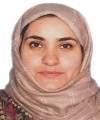
Download Paper
Paper Id : IJRASET66183
Publish Date : 2024-12-30
ISSN : 2321-9653
Publisher Name : IJRASET
DOI Link : Click Here
 Submit Paper Online
Submit Paper Online

